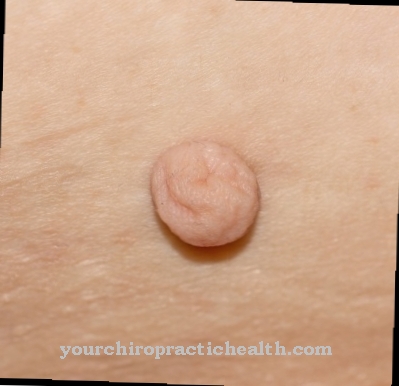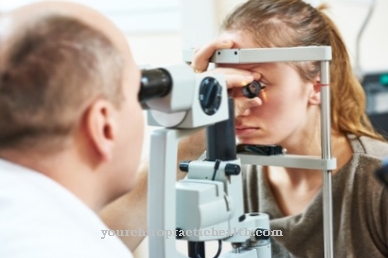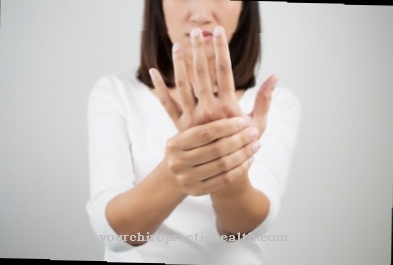As Epiphora or Tears is called a greatly increased flow of tears in the eye. Strictly speaking, this is more of a symptom than an illness itself, because Epiphora is a side effect of numerous eye diseases.
What is Epiphora?

A healthy eye is moistened and cleaned at regular intervals by means of tear formation and distribution. It is also protected against the ingress of foreign bodies such as dust and infestation with pathogens. With every blink a tear film spreads over the eyes and ensures unhindered and clear vision. The tears get into the eye through tubes made of small glands below the upper eyelid, the tear glands. These then flow away through the tear points, tiny, point-shaped openings in the corner of the eyelid next to the nose.
If there are disturbances at any point within this drainage system, this often results in excessive tear formation, the Tears. The vision becomes blurred, skin irritations and swellings (mucoceles) can occur, the susceptibility of the eye to infections increases. The trickling of tears can be present on both sides or be limited to just one eye. Basically, Epiphora occurs at any age. However, it is most common in infants under twelve months of age, as well as in adults over 60.
causes
The most common cause of Epiphora is blocked tear ducts. The tears cannot drain away and remain in the bags under the eyes. In adults, such a blockage often occurs as a direct accompaniment to the aging process. But inflammation can also promote the outbreak of an epiphora. In addition to many types of bacteria and microorganisms, inflammatory processes are triggered by autoimmune diseases such as vasculitis. Further possible causes are also pathological increases in intraocular pressure or severe stress such as facial operations.
Reasons for excessive tear formation, which, on the other hand, are not caused by blocked tear ducts, include irritation in the cornea or weaknesses in the facial muscles (e.g. as a result of a stroke), the so-called dry eye syndrome. In this disease, the chemical composition of the tears is faulty and consists mainly of water, which evaporates too quickly for the eyes to be effectively protected.
You can find your medication here
➔ Medicines for eye infectionsDiseases with this symptom
- House dust allergy
- Pet hair allergy
- Hailstone
- Wegener's disease
- hay fever
- allergy
- Conjunctivitis
- Iritis
- Mold allergy
- Drug allergy
- Contact allergy
- Glaucoma (green star)
Diagnosis & course of disease
Symptoms of Epiphora include excessive tear formation, dull eyelashes, or slimy discharge. A doctor who finds one or more of these abnormalities will conduct further detailed interviews regarding the symptoms. The patient's medical history is also relevant here. In general, Epiphora can be easily recognized by an experienced doctor. In further examinations, the doctor will then concentrate on determining the disease behind the tears.
For this purpose, the patient may also have to be anesthetized. As part of the examination, tiny tubes are inserted into the tear ducts to precisely determine the severity and position of the blockage. It is also common practice to administer fluid into the tear duct to check for drainage and evaporation through the nose. This can also contain a marking substance, by means of which the location of the blockage can be further specified, for example in the case of an X-ray exposure. The further course and the selection of the appropriate treatment also depend on the disease diagnosed in this way.
Complications
The term Epiphora is one that comes from the Greek. Translated into German, this is called tears. This term Epiphora is therefore used for various diseases of the eyes, in which there is a disproportion between the tear production in the lacrimal glands and the outflow of this tear fluid via the draining tear ducts. There are several reasons for this. For example, when the conjunctiva or the cornea of the eyes are mechanically irritated, tears almost always appear.
Also, irritation of the trigeminal nerve usually leads to increased tear production and tears then drip. Occasionally, the tears appear due to a disease of the paranasal sinuses. A hypertrophy of the lacrimal glands leads to tears not only temporarily. Stenoses of the draining tear ducts can also lead to the epiphora due to the resulting disturbance of the drainage of the tear fluid. Stenoses are narrowing of the tear ducts. These strictures can be both congenital and acquired.
Another aspect that can lead to epiphora is malposition of the teardrop points. In this case, too, such misalignments of the eyelids, which lead to the misalignment of these teardrop points, can already be present from birth. However, this is not always the case. Degenerative changes in the eyelids also often lead to a misalignment of the teardrop points and thus to tears. Sometimes even small children suffer from glaucoma.In these cases, too, tears will drip.
When should you go to the doctor?
The term Epiphora denotes an above-average flow of tears in the eye. To prevent dehydration, the eyes are constantly moistened with tear fluid. However, if the flow of tears is increased, it is perceived as uncomfortable. Epiphora is not only an annoying phenomenon, it can also be the reason to consult a doctor.
If there is no explanation for excessive lacrimation such as wind, onion cutting and of course emotional triggers such as laughing and crying, Epiphora can indicate an eye disease. Under no circumstances should those affected by Epiphora simply accept their constant tears. The possibly underlying disease can be serious and must be clarified by an ophthalmologist. The constant flow of tears can also reduce eyesight in the long term.
If the epiphora is based on a disease that requires treatment, certain environmental factors are often the cause. Here, too, the ophthalmologist with his experience is the ideal contact. He will give his patient helpful tips on how this can prevent excessive tearing: for example, make sure that the room air is not too dry, avoid drafts, limit alcohol consumption, take breaks at the computer or get enough sleep.
It is best to see an ophthalmologist first in the event of an epiphora. At the same time, consideration should also be given to calling in another specialist such as an internist. It cannot be ruled out that the epiphora has another disease as the cause.
Doctors & therapists in your area
Treatment & Therapy
Since Epiphora is a side effect of many diseases, it is necessary to obtain an exact diagnosis from a doctor before treatment. In general, it is always advisable to see an ophthalmologist if there is increased tearing over a longer period of time. If the teardrop is from a point obstacle, the most common type of treatment is opening and washing out the tear points.
This treatment can be done on an outpatient basis and is relatively uncomplicated, but has to be repeated several times a year. This procedure cannot be considered as a permanent solution. A blockage of the tear and nasal duct is often treated with what is known as a dacryocystorhinostomy, or DCR for short. A connection between the tear sac and the inside of the nose is formed via the access from the nose. This new opening then allows the tear fluid to drain unhindered.
The DCR is performed without any externally visible cuts and can be performed directly in the ophthalmologist's practice under anesthesia. It is a relatively low-risk treatment method that in most cases has excellent long-term effects. If, on the other hand, a dry eye syndrome has been diagnosed, the symptoms can be sustainably alleviated by several other measures.
The most common type of treatment is the administration of artificial tears in the form of eye drops. Such drops are mostly available without a prescription and ensure that the eyes are re-moistened. The treatment of dry eyes can also be sustainably supported by a humidifier. Moist ambient air actively counteracts dehydration of the eyes.
Outlook & forecast
Epiphora leads to increased tear flow and does not usually appear as an independent disease, but only as an accompanying symptom in other diseases. For this reason, the epiphora is also treated causally. The diagnosis of Epiphora is usually made without delay or compilations, so that treatment can be carried out at an early stage.
If the epiphora occurs only briefly, outpatient treatment can be carried out by the doctor, which must be repeated several times a year. If this is a permanent problem, a causal treatment must be carried out. As a rule, the treatment leads to quick and long-lasting success, so that the patient does not have to undergo repeated treatment. In some cases the use of eye drops is necessary.
The epiphora can severely restrict the everyday life of the person affected, so that many activities are no longer possible for the patient. Likewise, the constant watering of the eyes can lead to accidents or carelessness, which increases the risk of injury. If the Epiphora is treated, there is usually no reduction in life expectancy.
You can find your medication here
➔ Medicines for eye infectionsprevention
Since Epiphora can have a variety of causes, specific recommendations for prevention are not possible. In general, the following applies: the eye should always be kept moist and health risks should be kept low. Consciously regular blinking with the eye as well as avoiding smoke, wind and other irritations can significantly minimize the risk of tears.
In particular, people such as allergy sufferers, near-sighted and ametropia (especially contact lens wearers), as well as those who are older than 55 years and are at an increased risk of disease, should regularly consult a doctor to have their eyes checked.
You can do that yourself
An Ephiphora should always be clarified and treated by an ophthalmologist. However, those affected can often relieve watery eyes on their own by avoiding drafts, smoke and hot air (for example from the hairdryer or car blower). In addition, exercise in the fresh air and adequate sleep help to relieve the eyes and reduce the flow of tears. Regular ventilation and the most comfortable indoor climate possible help to protect the eyes and reduce the discomfort of the Ephiphora.
Comprehensive eye hygiene also helps: those affected should carefully clean their eyelid rims before going to sleep and, above all, remove make-up and other residues well. To reduce skin irritation, the eyes can be rinsed out regularly with clean water. Contact lens wearers can often reduce tears by cleaning the lenses thoroughly and regularly. If necessary, a lens change can also help to avoid watery eyes as a result of overload or irritation.
If the Ephiphora is due to another condition or an allergy, the respective underlying disease must first be treated. As an acute self-help measure, a simple change of the bedroom and increased eye hygiene are recommended.
























.jpg)



